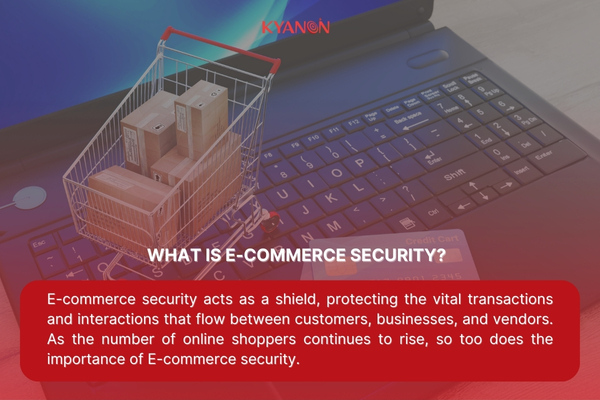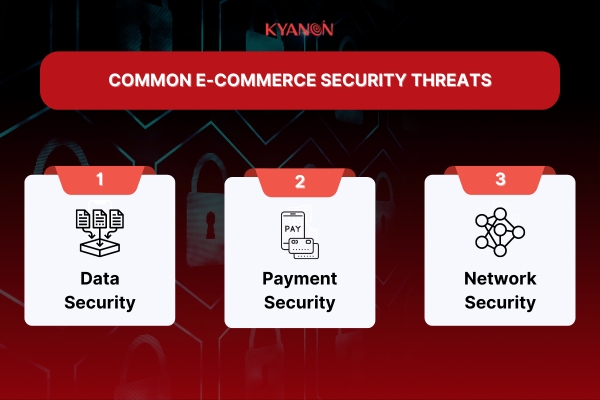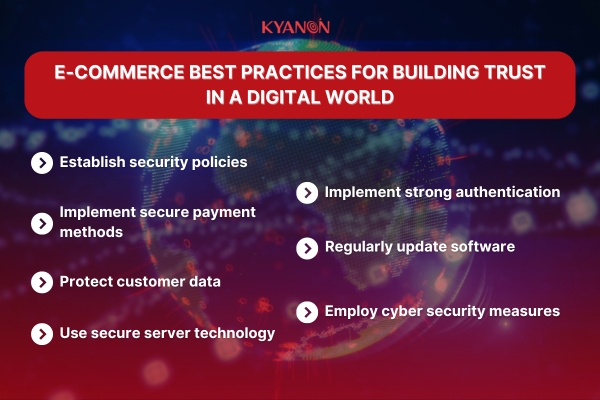In today’s online landscape, robust E-commerce security is the cornerstone of any thriving E-commerce business. The exponential growth of the internet has unfortunately been accompanied by a surge in cybercrime, making online fraud a significant threat. Without proper safeguards, these attacks can inflict substantial financial damage and severely tarnish a company’s reputation.
The scale of the problem is undeniable. A Statista report reveals that the E-commerce fraud detection and prevention market surpassed a staggering 28 billion U.S. dollars in 2020, with projections indicating a steady climb to over 69 billion U.S. dollars by 2025.
However, the benefits of E-commerce security extend far beyond financial protection. It safeguards a company’s reputation, a critical asset in the digital age. A data breach that compromises customer information can shatter trust and loyalty, potentially causing lasting harm. Let’s Kyanon Digital walk you through the E-commerce best practices for building trust in a digital world.
1. What is E-commerce security?
In the world of online shopping, E-commerce security acts as a shield, protecting the vital transactions and interactions that flow between customers, businesses, and vendors. As the number of online shoppers continues to rise, so too does the importance of E-commerce security. Businesses have a dual responsibility: safeguarding their customers’ data and securing their own operations from the ever-present threat of cybercrime.

The digital landscape is a battlefield, with cyberattacks escalating year after-year. This harsh reality demands that organizations become vigilant in implementing robust security protocols. After all, customer trust is the lifeblood of any E-commerce business.
Three key cybersecurity measures form a formidable shield against malicious actors: encryption, authentication, and authorization.
- Authentication: This acts as the gatekeeper, ensuring the legitimacy of both buyers and sellers. It verifies identities before allowing access, preventing unauthorized interactions.
- Encryption: Imagine a secure tunnel safeguarding your data. Encryption scrambles information transmitted online, making it unreadable to anyone who shouldn’t see it. This protects sensitive customer details like credit card numbers.
- Authorization: Think of it as a tiered access system. Authorization controls what actions users can take. This ensures that only authorized personnel have access to sensitive information and functionalities within the E-commerce platform.
By implementing these measures, E-commerce businesses can build a fortress of trust with their customers, fostering a secure and thriving online marketplace.
2. Common E-commerce security threats
As E-commerce booms, so do the shadows lurking in the digital space. Businesses must become increasingly vigilant about data security. Understanding the common online threats and implementing robust safeguards are crucial to protecting valuable customer information.

2.1. Data Security
At the core of a secure E-commerce experience lies robust data security. This involves safeguarding customer information from a range of threats, including hackers attempting to steal data, malware designed to disrupt operations, and denial-of-service attacks aiming to overwhelm systems.
- Hacking: In these attacks, unauthorized individuals exploit weaknesses to gain access to computer systems or networks. Hackers can wreak havoc, stealing sensitive customer data, manipulating or erasing files, or even seizing control of the entire system. To fortify their defenses, businesses should prioritize robust security measures. This includes enforcing strong passwords and multi-factor authentication, utilizing secure connections, and diligently patching software vulnerabilities.
- Malware: Malicious software, or malware, lurks as a constant threat to E-commerce operations. This harmful software, encompassing viruses, ransomware, and spyware, can wreak havoc on computer systems. To combat this threat, businesses should utilize anti-malware software and consistently scan their systems to identify and eliminate any potential malware infections.
- Denial of Service (DoS) Attacks: Denial-of-service (DoS) attacks aim to cripple E-commerce businesses by overwhelming their systems with a deluge of traffic or requests. This malicious flood can grind websites to a halt, hindering customer access and order processing. DoS attacks can cause significant disruptions, ranging from frustrating slowdowns to complete crashes, ultimately harming the E-commerce experience.
2.2. Payment Security
- Credit Card Fraud: Fraudsters exploit stolen credit card numbers to make unauthorized purchases on unsuspecting customers’ dimes. To fortify their defenses, businesses should prioritize PCI compliance (Payment Card Industry Data Security Standard). PCI compliance mandates a set of robust security measures, including the use of Secure Sockets Layer (SSL) encryption to scramble data during transmission, and tokenization, which replaces sensitive credit card details with unique digital tokens, further reducing the risk of stolen information.
- Phishing: Phishing scams are a cunning method cybercriminals use to steal sensitive information. These deceptive emails masquerade as legitimate sources, such as banks or trusted companies, to trick victims into clicking malicious links or opening attachments. These links or attachments can then install malware that harvests data or redirects users to fake websites designed to steal login credentials or financial details. Phishing attacks pose a significant threat to both E-commerce businesses and their customers.
- Skimming: E-commerce merchants also face a threat called skimming, but in the digital realm. Here, malicious actors inject hidden code onto a website’s payment page. This code then captures sensitive customer information, like credit card details, as it’s being entered. Unlike physical skimmers, these can be difficult to detect. To combat E-commerce skimming, businesses should prioritize website security, implement robust monitoring tools, and stay updated on the latest threats.

2.3. Network Security
This means keeping your network fortified with the latest security protocols and employing a secure architecture. Constant vigilance is crucial, so regular network monitoring is essential. Network scanning and intrusion detection systems serve as your digital watchdogs, identifying and thwarting potential threats before they can infiltrate your systems.
- Unauthorized Access: Unauthorized access looms as a constant threat in the E-commerce landscape. Malicious actors can exploit vulnerabilities through malware, phishing scams, and other cunning methods to gain unauthorized access to systems. To fortify defenses, businesses must prioritize robust system security and implement strong authentication methods. This can involve multi-factor authentication, which adds an extra layer of verification beyond just passwords, significantly deterring unauthorized access attempts.
- Insecure Network Infrastructure: Regular updates and maintenance are crucial to patch vulnerabilities that hackers can exploit. Furthermore, a layered defense approach is essential. Firewalls act as the castle walls, guarding the network perimeter. VPNs (Virtual Private Networks) create secure tunnels for encrypted data transmission, and additional security measures add further protection, all working together to create a robust defense system.
- Poor Password Management: Strong, unique passwords are essential for all accounts, and regular password updates are crucial to stay ahead of evolving threats. This applies not only to the business itself but also to staff members. Enforce a policy of unique, complex passwords for each employee, and educate them on the dangers of sharing credentials. Consider implementing password management tools to simplify strong password creation and storage for everyone.
Transform your ideas into reality with our services. Get started today!
Our team will contact you within 24 hours.
3. E-commerce Best Practices for building trust in a digital world
In the ever-evolving digital landscape, security is the cornerstone of trust in E-commerce. By implementing these measures, you can significantly reduce the risk of security breaches, protecting both your business and your valued customers. Stay tuned for further insights on building a robust E-commerce security strategy.

3.1. Establish security policies
To ensure customer trust and business security, establish clear E-commerce policies that train staff, safeguard customer data, encrypt transactions to shield sensitive information, and prioritize compliance with all legal and regulatory requirements for your website.
3.2. Implement secure payment methods
Beyond secure web pages with SSL certificates, fortify your online store with robust payment methods. Utilize encryption technology and secure servers (HTTPS) to safeguard transactions. Consider not storing sensitive cardholder data if unnecessary. Furthermore, encourage strong customer passwords and add CAPTCHA verification to payment forms for an extra layer of security.
3.3. Protect customer data
Fortify customer data by minimizing collection to what’s essential, adhering to regulations like GDPR and CCPA. Encrypt all Personally Identifiable Information (PII) using strong methods. Implement robust security protocols like SSL and HTTPS to shield data in transit, and prioritize E-commerce platforms with cutting-edge security practices for maximum protection.

3.4. Use secure server technology
Secure server technology acts as a digital vault, encrypting data in transit over the internet. This scrambles information like credit card details and passwords, making it unreadable to prying eyes. Additionally, it allows businesses to verify user identities, preventing unauthorized access and bolstering customer confidence. By implementing secure server technology, businesses create a safe shopping environment, fostering trust and loyalty.
3.5. Implement strong authentication
Strong authentication is your secret weapon. Forget usernames and passwords – it demands additional verification for account access and transactions. Think of it as a multi-layered security fortress, significantly deterring unauthorized entry. Strong authentication isn’t just a security measure – it’s a strategic investment in your E-commerce empire. It safeguards data, fosters trust, and ensures regulatory compliance, paving the way for a secure and thriving business.
3.6. Regularly update software
Software vulnerabilities are an attacker’s playground. Staying on top of software and application updates – especially security patches – is crucial. These updates often address newly discovered vulnerabilities, effectively closing those gaps and hardening your defenses. Proactive patching minimizes the attack surface and safeguards sensitive customer data, preventing costly breaches and reputational damage.

3.7. Employ cyber security measures
Implementing cybersecurity measures is crucial for businesses. This involves adopting secure server technologies like firewalls and antivirus software, and educating your team on cybersecurity best practices.
E-commerce businesses can leverage various cybersecurity tools to safeguard their digital platforms and customer data. These tools encompass firewalls, malware scans, and antivirus software.
Additionally, companies can enhance security by offering secure payment options such as PayPal or Apple Pay, which add extra encryption layers to online transactions. These steps help protect customer information from unauthorized access by hackers and other malicious entities.
4. Kyanon Digital: Your tech partner for E-commerce success

In the fast-paced world of E-commerce, success hinges on leveraging cutting-edge technology to drive innovation, efficiency, and customer satisfaction. At Kyanon Digital, we specialize in partnering with businesses to navigate and thrive in this digital landscape. With our expertise and dedication to excellence, we empower E-commerce ventures to achieve their goals, streamline operations, and deliver exceptional experiences to their customers.
Whether you’re looking to optimize your online presence, enhance user interfaces, or implement robust E-commerce solutions, contact Kyanon Digital for transforming visions into reality.

















